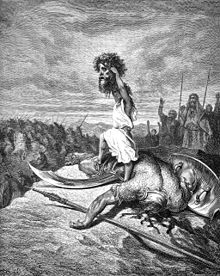| Revision as of 21:03, 2 November 2008 editRapi'uma (talk | contribs)7 edits →See also← Previous edit | Revision as of 21:05, 2 November 2008 edit undoRapi'uma (talk | contribs)7 editsNo edit summaryNext edit → | ||
| Line 1: | Line 1: | ||
| ] | |||
| ]The '''Rephaites''' (רפאים also known as Zamzummites, Anakites, and Emites) were a grouping of tall peoples mentioned in the ] that lived between the ] and the ] during the time of ] (Abram) ({{sourcetext|source=Bible|version=King James|book=Genesis|chapter=15|verse=20|Range=-21}}). They were considered by Joshua's scouts to be equivalent to the ]. | |||
| The ] and ] were sometimes considered part of this group <ref>{{bibleverse||Deuteronomy|2:10-12|31}}</ref> but sometimes separate <ref>{{bibleverse||Deuteronomy|2:20|NIV}} refers to the Rephaites being "as tall as the Anakites", not the Anaiktes.</ref>. The Bible records that ] used the ]ites to destroy the Rephaites in {{bibleverse||Deuteronomy|2:19-21|31}}. The giant size of the Rephaites is illustrated by the bed of ], king of ] that was "made of iron and was more than thirteen feet long and six feet wide" ({{bibleverse||Deuteronomy|3:10-12|NIV}}). During the time of ], several ] warriors including ], are considered Rephaites <ref>{{bibleverse|1|Chronicles|20:4|NIV}}</ref>. | |||
| The '''Rephaites''' are represented in Hebrew by the root rp', a root which is also found within Ugaritic texts. The Ugaritic text KTU 1.108 uses the term 'king' in association with the root rp' and place names that probably correspond to Ashtaroth and Edrei in the Bible, places with which Og is associated <ref>{{bibleverse||Deuteronomy|1:4|NIV}}; {{bibleverse||Joshua|9:10|NIV}}; {{bibleverse||Joshua|12:4|NIV}}; {{bibleverse||Joshua|13:12|NIV}}, {{bibleverse||Joshua|31|NIV}}</ref>. This may provide confirmation of traditions about the royal dynasty of Og and his lineage. | |||
| The ]ic texts of the ''Legend of Danel'' concern the hero '''Danel the Rephaite''',<ref>The name is rendered <small>DNL</small>.</ref> who was known as "judging the cause of the widow, adjudicating the case of the fatherless" ('']'', 149-51.) His soul was revived by ]. | |||
| In the Hebrew Bible (Christian "Old Testament") the term "Rephaim" (Heb. רפאים; not "Rephaite," as the title of this article incorrectly states) has two primary meanings: | In the Hebrew Bible (Christian "Old Testament") the term "Rephaim" (Heb. רפאים; not "Rephaite," as the title of this article incorrectly states) has two primary meanings: | ||
Revision as of 21:05, 2 November 2008

In the Hebrew Bible (Christian "Old Testament") the term "Rephaim" (Heb. רפאים; not "Rephaite," as the title of this article incorrectly states) has two primary meanings:
1. "Rephaim" can describe an ancient "race" of giants in Iron Age Israel/Palestine, or the places where these individuals were thought to have lived: see Gen. 14:5, 15:20; Deut. 2:10-1,20, 3:11,13; Josh. 12:4, 13:12, 15:8, 17:15, 18:16; 2Sam. 5:11,22, 23:13; 1Chr. 11:15, 14:9, 20:4. In the biblical narrative, the Israelites are instructed to exterminate the previous inhabitants of the "promised land," i.e. "Canaan," which include various named peoples, including various groups of unusually tall/large individuals. See the passages listed above in the book of Joshua, and also Deut. 3:11, which implies that Og, the King of Bashan, was one of the last survivors of the Rephaim, and that his bed was 9 cubits long (i.e., about 18 feet/5 meters, implying he was a giant).
2. The residents of Sheol (a biblical term for the land of the dead in the HB/OT) are often called רפאים (Isa. 14:9, 26:14,19; Ps. 88:11; Prov. 2:18, 9:18, 21:16; Job. 26:5; possibly 2Chron. 16:12, where we may read “Repha'im,” i.e. "dead ancestors," as opposed to Rophe’im, “doctors”). The Heb. root רפא means "heal," and thus the masc. plural nominalized form of this root may indicate that these deceased ancestors could be invoked for ritual purposes that would benefit the living.
Note also that various ancient Northwest Semitic texts are replete with references to the Rephaim as the dead or dead kings; see KAI 13.7-8, 14.8, 177.1; CTA 6.6.46-52, CTA 20-22 = KTU 1.161 (see the article by M.S. Smith, “Rephaim,” in the Anchor Bible Dictionary). In the very thorough study of T.J. Lewis (professor of Hebrew Bible at Johns Hopkins University), Cults of the Dead in Ancient Israel and Ugarit (Scholars Press, 1989), Lewis undertakes a detailed study of several enigmatic funerary ritual texts from the ancient coastal city of Ugarit. Lewis concludes that the "Ugaritic Funerary Text" (KTU 1.161 = RS 34.126) provides important evidence for understanding Ugarit's cult of the dead, wherein beings called rapi'uma, the long dead, and malakuma, recently dead kings, were invoked in a funeral liturgy, presented with food/drink offerings, and asked to provide blessings for the reign of the current king. The many references to repha'im in the HB/OT in contexts involving Sheol and dead spirits strongly suggests that many ancient Israelites imagined the spirits of the dead as playing an active and important role in securing blessings, healing, or other benefits in the lives of the living. On the role of the dead and burial customs in ancient Israelite society and the cultures of ancient Syro-Palestine generally, see L. Bloch-Smith's Judahite Burial Practices and Beliefs About the Dead (Continuum, 1992).